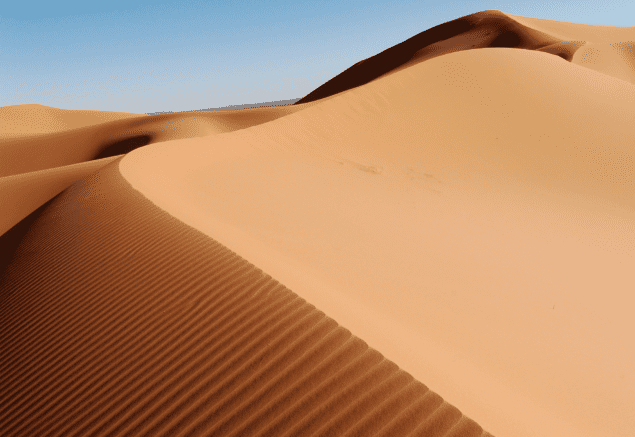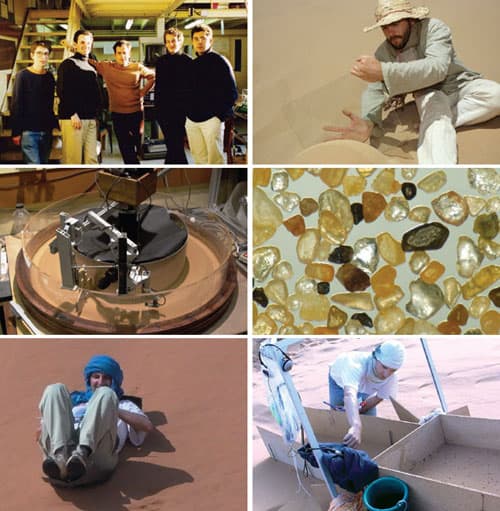
If you go to a sandy desert or beach on a blustery day, you might see a range of topographic features created by the wind. Looking down at your feet, you may notice centimetre-scale periodic ripples made by hopping grains of sand. You could also explore much larger sand dunes that form on length scales of tens of metres.
Ripples and dunes are thought to form in very different ways and in most sandy environments you will not see periodic structures at intermediate length scales – often referred to as the “forbidden region”. There are exceptions to this rule, and unusually-large “megaripples” are found in some places. Now, researchers at the University of Leipzig in Germany and Ben-Gurion University of the Negev in Israel have worked out that these structures form in much the same way as larger sand dunes.
Sand ripples are thought to be caused by a synchronization of the hopping of grains of windblown sand with emerging waves in the sand bed. The ripples are rarely larger than a few centimetres wide, and tend to be regularly spaced, with about 10 cm between peaks.
A mighty wind
Dunes result from the asymmetric way the wind blows over obstacles: “If you stand on top of a hill, the strongest wind is not exactly at the top: it’s slightly upwind of this position,” explains Leipzig’s Klaus Kroy. The maximum mass of a particle that can become airborne increases with the airflow rate, so, as the wind slows down slightly at the top of a dune, it deposits more sand, making the dune bigger.
Normally sand does not fly continuously in the wind but travels in discrete hops several centimetres long. For a dune smaller than about 10 m in length, this hop length is longer than the distance the point of strongest wind is displaced from the dune crest. Therefore, sand picked up from the windward side of a dune is not deposited on the crest and the dune is eroded by the wind.
These rare intermediate structures are known as megaripples and have, until now, lacked any theoretical explanation. As the name implies, they have generally been studied as unusually large ripples, but this has only deepened the mystery. For example, ordinary ripples tend to be periodic, and are neatly characterized by the distance between successive peaks. However, says Kroy, megaripples “don’t care where the nearest neighbour is”. Furthermore, megaripples tend to be covered with coarse sand: “People were saying to me things like ‘It’s really hard to understand why the coarse grains always accumulate on them,'” says Kroy.
Bimodal grains
Treating megaripples as dunes explains why they are not periodic, but raises other questions. They are often not much more than 30 cm in length, so how can they be stable? The researchers present a mathematical model of how, under specific geological conditions, the distribution of sand grain masses can become bimodal: fine, light grains perform large jumps in the wind and heavier, coarser grains creep along the sand bed in small jumps, pushed along by repeated impacts from the lighter grains.
These heavier grains respond to changes in wind speed on much shorter length scales than the lighter grains, so they can build much smaller dunes. Unlike large dunes, however, megaripples are transient features prone to destruction by storms. This, say the researchers, is because the coarser grains of sand will make large jumps in very high winds, making small dunes unstable.

The troubled song of the sand dunes
The team confirmed its hypothesis by studying cross sections of megaripples in the southern Negev desert in Israel. They also used previously published data: “We show people how to look at the available data and reinterpret it in a different way,” explains Kroy.
Kroy suggests that the analysis technique could be further developed for use in other fields. “[Researchers have] found small ripples on the surface of the comet that passed near Earth recently, even though there’s no atmosphere,” he says, “Under such conditions, you can immediately see that there must – quite unexpectedly – be some wind.” He also says that studies of petrified megaripples could tell us something about conditions long ago on Earth when the features formed.
Geoscientist Nathalie Vriend of the University of Cambridge is impressed with the research: “There have been observations of megaripples before, but this is one of the first papers that really puts some physical modelling behind them,” she says. She cautions, however, that the researchers’ dynamical ideas about the effects of various wind speeds on sand grain size need field testing.
The research is described in Nature Physics.



